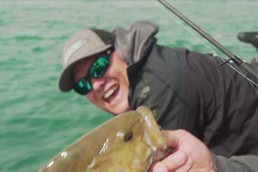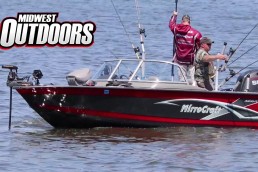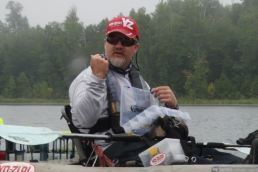Experience Fishing for Pike in a Tube Boat
SHARE THIS POST
My float tube began sliding over the surface, dragged by a yet unseen force. But I knew what was pulling me–a dandy-sized northern pike.
Minnesota, Wisconsin and Michigan are pockmarked by thousands of small lakes. And most of them have healthy populations of pike. Some of the lakes have public access sites; many do not. Some are entirely enclosed by private land and the rights of landowners must be respected. Some are within the boundaries of public land and even if hiking into the back country is required, fishing is a good prospect.
Among my favorite means of access to these small lakes is via my tube boat. Tube boats were originally inflated truck tires with some sort of seat in the center with holes to stick legs through. It was tough to get into such devices because the flippers used to propel and maneuver the tires had to go through holes in webbing leaving enough support to hold the angler. Modern tube boats are much easier to use. Mine is a U-tube sort of thing with one side open.
After inflating the tube and the auxiliary bladder which serves as a back rest, I wade into the lake with flippers in place (spectators love to watch this), sit on the webbed seat, fasten the safety straps which prevent sliding off the seat, and paddle off. My boat came with straps comparable to those on a backpack making it possible to carry it into remote lakes that rarely are visited by anglers.
As with any outdoor activity, safety is a concern. A few years ago, Dr. Bobby Dale of Tupelo, Mississippi spoke at the Southeastern Outdoor Press Association on the subject of first aid. When I said the most important first aid consideration was “good judgment,” he readily agreed. Several “good judgment” factors apply to tube boating.
Tube boats are incredibly vulnerable to wind. On one of my first serious uses of my tube boat, I was fishing for trout on a small stock pond in Wyoming. The pond was not more than 100 feet across. By the time I had all the straps on my rig in place, wind scooted me across the entire pond and my fins were dragging on the bottom. My wife thought my plight very funny.
On windy days, don’t bother. The good thing that could happen is you get blown across the lake. Very possibly, you could end up far from the spot you started and need to return, or in a hostile place like a field with some farmer’s bull. My rule on the lakes I often fish in Michigan’s Upper Peninsula is no lake over 100 surface acres and never on a windy day.
Another factor is use of a life preserver. A few years ago, I purchased a life preserver designed for use by canoe and kayak operators. It is shorter than most, a must for tube boat operators. When sitting in the tube, the distance between shoulders and where the preserver has to end should be shorter than when you’re in a boat. A few years ago, while pike fishing in the UP, I wiggled about in my tube and bumped the valve in the tube. The plug popped out and the tube began to lose air—fast. I was darn glad I had my life preserver.
Are you enjoying this post?
You can be among the first to get the latest info on where to go, what to use and how to use it!
I always use my waders when fishing out of my tube boat. While 70 degrees seems plenty warm on a nice summer day, immersing your legs in water that cool for several hours leads to chills. Not worth it, in my view.
Bulky tackle boxes, the sort most of us carry, are not practical for tube boat fishing. My selection of gear to take always includes a pair of needle nose pliers, attached to the tube with some sort of cord. My boat has a series of D-rings and I loop a tether for my pliers on one of the D-rings. My lure selection is limited to half a dozen or so pike favorites in the best couple of colors. I also always carry drinking water.
Casting is constrained from a tube boat. It’s tough to heave a lure long distances because you can’t put your whole body into the effort. You need to use your wrist and forearm, just as you were taught. At the same time, you are not making a fish-disturbing approach as with a boat. There are trade-offs.
A long-time fan of fly-fishing for pike, I often use my 8-weight fly rod from my tube boat. Fly-casting is especially constrained with the fly rod because you are so close to the water surface.
If you don’t have a small lake with lots of pike on your list of spots to go, how would you find one? DeLorme’s Atlas and Gazetteer for each state would be a good place to start. Look for lakes in state or national forests. Though there may be private land scattered throughout the public land, lakes there are good prospects.
For Michigan, consult Tom Huggler’s series Fish Michigan. I suspect there are comparable guides to other states that I do not know. Local outposts of state natural resource agencies usually have ardent anglers on staff, and they may know of suitable lakes. If you get your oil changed while traveling, ask folks. I’ve been given some good tips from a shop I visit. Get your hair cut at a local barbershop. Ask around, telling residents what you are looking for.
Most of the small lakes I fish with my tube boat are unlikely to hold a trophy pike. Perhaps the biggest pike I have caught from my tube is seven pounds. Nonetheless, a four- or five-pound pike can drag me around. In the years since I started, I’ve been fortunate to fish for and catch trophy pike. Yet, the pike of these small lakes are the pike of my youth, the fish that started me on a long love affair. The day I catch a bunch of them—heck, the day I catch one—and I don’t call it a great day will be a sad day indeed.
Give pike fishing from a tube boat a try in the thousands of small lakes in the Upper Midwest. You can get to small lakes without boat ramps, perhaps lakes rarely visited. Who knows, you might even catch a trophy. There is a small lake in the central UP with a reputation for big pike. I’ve never caught a 40-inch pike there, but I keep trying. It’s a mile hike through the woods to get there, but with my tube boat on my back, I can do it.
MWO
SHARE THIS POST
Did you enjoy this post?
You can be among the first to get the latest info on where to go, what to use and how to use it!
Tim Mead
Tim Mead is an established outdoor writer and photographer with more than 500 credits in state, regional and national magazines. He is an “Excellence in Craft” award winner from both the Outdoor Writers Association of America (of which he is also vice president) and the Southeast Outdoor Press Association (as well as being past president).



